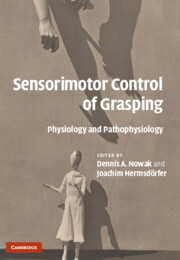Book contents
- Frontmatter
- Contents
- List of contributors
- Preface
- Part I Methodology
- Part II The physiology of grasping
- 10 The study of hand movements during grasping. A historical perspective
- 11 Sensory control of object manipulation
- 12 Predictive mechanisms and object representations used in object manipulation
- 13 The neurohaptic control of the hand
- 14 Points for precision grip
- 15 Two hands in object-oriented action
- 16 Dynamic grasp control during gait
- 17 Development of grasping and object manipulation
- 18 The effects of aging on sensorimotor control of the hand
- Part III The pathophysiology of grasping
- Part IV Therapy of impaired grasping
- Index
- Plate section
- References
11 - Sensory control of object manipulation
Published online by Cambridge University Press: 23 December 2009
- Frontmatter
- Contents
- List of contributors
- Preface
- Part I Methodology
- Part II The physiology of grasping
- 10 The study of hand movements during grasping. A historical perspective
- 11 Sensory control of object manipulation
- 12 Predictive mechanisms and object representations used in object manipulation
- 13 The neurohaptic control of the hand
- 14 Points for precision grip
- 15 Two hands in object-oriented action
- 16 Dynamic grasp control during gait
- 17 Development of grasping and object manipulation
- 18 The effects of aging on sensorimotor control of the hand
- Part III The pathophysiology of grasping
- Part IV Therapy of impaired grasping
- Index
- Plate section
- References
Summary
Summary
Series of action phases characterize natural object manipulation tasks where each phase is responsible for satisfying a task subgoal. Subgoal attainment typically corresponds to distinct mechanical contact events, either involving the making or breaking of contact between the digits and an object or between a held object and another object. Subgoals are realized by the brain selecting and sequentially implementing suitable action-phase controllers that use sensory predictions and afferents signals in specific ways to tailor the motor output in anticipation of requirements imposed by objects' physical properties. This chapter discusses the use of tactile and visual sensory information in this context. It highlights the importance of sensory predictions, especially related to the discrete and distinct sensory events associated with contact events linked to subgoal completion, and considers how sensory signals influence and interact with such predictions in the control of manipulation tasks.
Sensory systems supporting object manipulation
In addition to multiple motor systems (arm, hand, posture), most natural object manipulation tasks engage multiple sensory systems. Vision provides critical information for control of task kinematics. In reaching, we use vision to locate objects in the environment and to identify contact sites for the digits that will be stable and advantageous for various actions we want to perform with the grasped object (Goodale et al., 1994; Santello & Soechting, 1998; Cohen & Rosenbaum, 2004; Cuijpers et al., 2004; Lukos et al., 2007).
- Type
- Chapter
- Information
- Sensorimotor Control of GraspingPhysiology and Pathophysiology, pp. 141 - 160Publisher: Cambridge University PressPrint publication year: 2009
References
- 17
- Cited by

